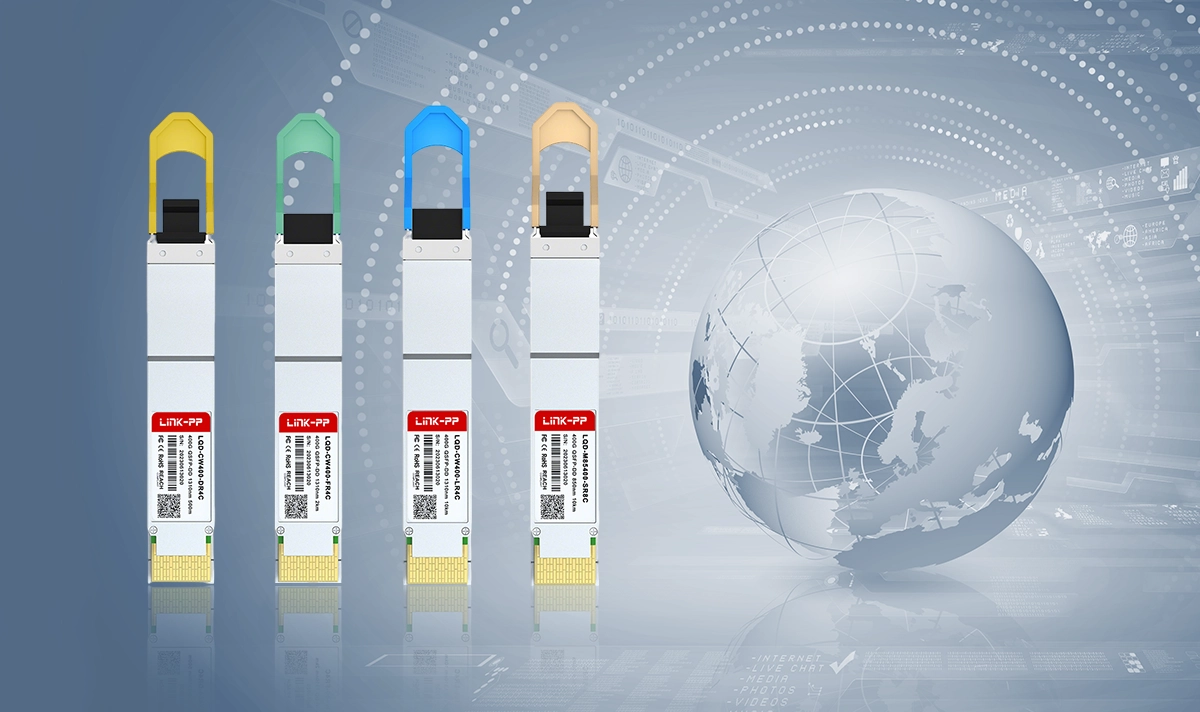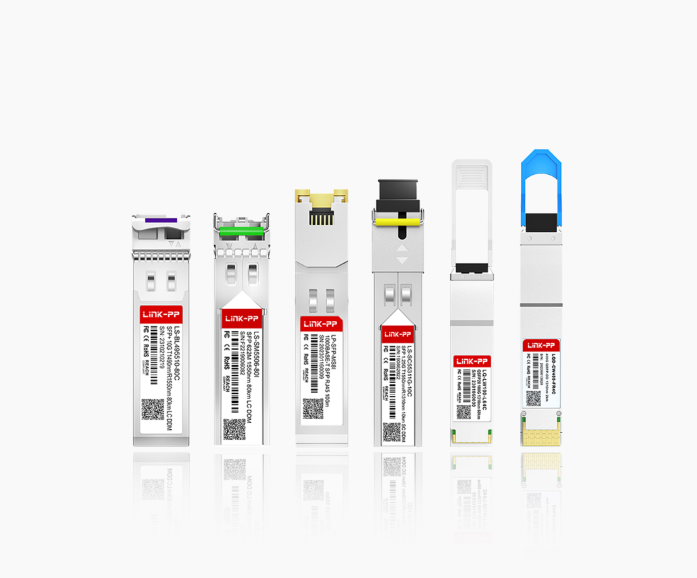
In the relentless pursuit of artificial intelligence (AI) supremacy, the computational heart is no longer a single, powerful GPU. Instead, it's the intricate, high-speed network connecting thousands of them—a system known as the AI fabric. This fabric is the central nervous system of massive-scale AI training clusters, where data must flow between GPUs with unprecedented speed and minimal latency. As models grow into the trillions of parameters, the bottleneck often shifts from raw compute to interconnect performance.
At the physical layer of this fabric, where electrical signals convert to light for high-speed travel, lies a critical yet often overlooked component: the optical transceiver. Optimizing these tiny powerhouses is not just an engineering detail; it's a fundamental requirement for unlocking the full potential of GPU-to-GPU communication. This article delves into how advanced optical transceivers, including cutting-edge solutions from innovators like LINK-PP, are paving the way for the next generation of AI infrastructure.
📜 Understanding the AI Fabric and GPU-to-GPU Communication
An AI fabric is a specialized network architecture designed explicitly for connecting GPUs and other accelerators in large-scale clusters. Unlike traditional data center networks built for general-purpose east-west traffic, AI fabrics are engineered for a singular purpose: to facilitate the all-to-all communication patterns inherent in distributed model training.
Why is GPU-to-GPU Communication So Critical?
In parallelized AI training, workloads are split across hundreds or thousands of GPUs. During each training step, these GPUs must synchronize their computed gradients. The time spent communicating can easily overshadow the time spent computing if the interconnects are slow. This is known as the communication bottleneck.
Low Latency: Minimizing the time it takes for a data packet to travel from one GPU to another is paramount. Every microsecond of delay adds up, slowing down the entire training job.
High Bandwidth: The sheer volume of data exchanged during synchronization requires immense bandwidth. Modern clusters are moving beyond 400G towards 800G and 1.6T interconnects.
Scalability: The fabric must maintain performance consistently as the cluster grows from dozens to thousands of nodes without introducing disproportionate latency or complexity.
Protocols like NVIDIA's NVLink and Infiniband are commonly used within these fabrics, but they all ultimately rely on physical hardware—copper cables or, for longer distances and higher densities, optical transceivers—to move the data.
📜 The Crucial Role of Optical Transceivers in AI Clusters

Optical transceivers are the bilingual interpreters of the data center. They take electrical signals from GPUs and switches, convert them into light pulses, and transmit them over fiber optic cables. At the other end, another transceiver converts the light back into electrical signals.
In the context of an AI fabric, their role expands from a simple converter to a performance-defining component.
Key Transceiver Metrics for AI Workloads:
Data Rate: Measured in gigabits per second (Gbps). Higher rates like 400G, 800G, and soon 1.6T are essential for handling the data deluge.
Power Consumption: Transceivers generate heat. In a dense rack with hundreds of units, lower power consumption (measured in watts) directly translates to lower cooling costs and higher energy efficiency—a critical factor for sustainable AI infrastructure.
Latency: The conversion process itself adds a tiny but measurable delay. High-quality, optimized transceivers minimize this added latency.
Reach: Different parts of a cluster have different connectivity needs, from intra-rack (a few meters) to inter-rack (up to hundreds of meters).
📜 A Deep Dive into Optical Transceiver Technology for AI
This section focuses on the specific technologies that make modern optical transceivers suitable for the demanding environment of GPU-to-GPU communication.
Form Factors and Standards
The industry has standardized around form factors like QSFP-DD (Quad Small Form-factor Pluggable Double Density) and OSFP (Octal Small Form-factor Pluggable) to support higher densities and data rates. The OSFP form factor, for instance, is particularly well-suited for 800G applications and beyond, offering a robust design for higher power budgets.
Co-Packaged Optics (CPO): The Future on the Horizon?
A significant emerging trend is Co-Packaged Optics, where the optical engine is moved closer to the switch ASIC, reducing power consumption and improving signal integrity. While CPO promises revolutionary gains, pluggable transceivers like those from LINK-PP will remain the dominant and most flexible solution for the foreseeable future, allowing for easy upgrades and maintenance without replacing entire switch systems.
Introducing the LINK-PP 800G-DR4 Transceiver
When building a high-performance AI fabric, selecting the right transceiver model is crucial. For applications requiring high bandwidth and cost-effectiveness over short to medium distances, the LINK-PP 800G-DR4 optical transceiver stands out.
This transceiver is engineered for maximum performance in AI and HPC environments. It supports an 800G data rate using four lanes of 100G PAM4 modulation. Its low power dissipation and high-performance digital signal processing (DSP) ensure clean signal integrity, which is vital for maintaining low bit error rates (BER) in sensitive GPU communication. By integrating solutions like the LINK-PP 800G-DR4, data center operators can directly address the core challenges of scalable AI fabric deployment, ensuring reliable and efficient connectivity between GPU nodes.
The table below compares common 800G transceiver types relevant for AI cluster deployments:
Transceiver Type | Form Factor | Reach | Fiber Type | Key Use Case in AI Fabric | Relative Cost |
|---|---|---|---|---|---|
800G-SR8 | QSFP-DD/OSFP | Up to 100m | Multimode (OM4) | High-density intra-rack connectivity | Low |
800G-DR4 | QSFP-DD/OSFP | Up to 500m | Single-mode | Ideal for inter-rack links (e.g., LINK-PP) | Medium |
800G-FR4 | QSFP-DD/OSFP | Up to 2km | Single-mode | Campus-scale AI cluster connectivity | High |
800G-LR4 | QSFP-DD/OSFP | Up to 10km | Single-mode | Long-distance data center interconnects | Highest |
📜 Optimization Strategies for Peak Performance
Simply installing the latest transceivers is not enough. To truly optimize GPU-to-GPU communication, a holistic approach is required.
Matching Transceiver to Distance: Avoid over-specifying. Using a 10km-capable LR4 transceiver for a 50-meter inter-rack link is wasteful in both cost and power. The LINK-PP 800G-DR4 is a perfect fit for most inter-rack scenarios, balancing performance and economy.
Monitoring and Analytics: Implement a network monitoring system that tracks transceiver health metrics like temperature, transmit/receive power, and bias current. Proactive monitoring can predict failures before they cause costly training job interruptions.
Fiber Plant Management: The quality of the fiber optic cabling and connectors is paramount. Ensure clean connectors and use the correct fiber type (multimode for short reach, single-mode for longer reach) to prevent signal degradation.
Firmware and Compatibility: Keep transceiver firmware updated and ensure full compatibility with your specific switch and GPU hardware. Reputable vendors like LINK-PP provide robust compatibility matrices and support.
Thermal Management: ➡️ Design rack layouts with adequate airflow to prevent optical transceivers from overheating, which can lead to increased error rates and reduced lifespan.
📜 The Future: What's Next for AI Fabrics and Interconnects?
The trajectory is clear: more bandwidth, lower latency, and greater integration.
1.6T and Beyond: The industry is already developing the next generation of transceivers to support 1.6T (1600G) data rates, which will be necessary for future AI models.
Co-Packaged Optics Evolution: While still emerging, CPO will eventually become more mainstream, offering a path to even greater energy efficiency for the largest hyperscale AI clusters.
Intelligent Networks: Networks will become more "AI-aware," with the fabric dynamically routing traffic to avoid congestion and optimize high-performance GPU interconnect solutions based on the real-time communication patterns of the training workload.
📜 Conclusion: Building Smarter AI Fabrics
Constructing a high-performance AI fabric is a complex puzzle where every piece must fit perfectly. The optical transceiver, once a simple commodity, is now a strategic component that directly impacts training time, operational cost, and scalability. By focusing on optimization—selecting the right transceiver for the right job, maintaining the physical infrastructure, and partnering with innovative suppliers—we can build the robust, low-latency foundations that future AI breakthroughs will depend on.
Integrating high-quality, reliable components like the LINK-PP High-Speed optical transceiver is a definitive step towards achieving an optimized, efficient, and powerful AI fabric, ready to tackle the computational challenges of tomorrow.
📜 FAQ
What is an optical transceiver in AI fabrics?
An optical transceiver lets your GPU devices send and receive data using light signals. You use these parts to connect GPUs with fast, reliable links. Optical transceivers help your AI network work better than old copper cables.
Why should you choose optical over copper for GPU clusters?
Optical links move data faster and use less power. You get lower latency and higher bandwidth. Your AI workloads run smoother. Copper cables cannot match the speed or efficiency of optical connections.
How do you keep your AI fabric cool and efficient?
You should pick optical transceivers that use less energy. Space your GPU devices apart. Use cooling systems to move heat away. Watch your network for hot spots and fix them quickly.
What makes co-packaged optics important for AI networks?
Co-packaged optics put data links close to GPU chips. You get faster data movement and lower latency. Your network uses less power. This setup helps you build bigger and stronger AI clusters.
How do you check if your optical network is reliable?
Test your network often. Use error-checking features in your optical transceivers. Back up your network paths. Watch for slow spots or dropped data. Fix problems as soon as you find them.




